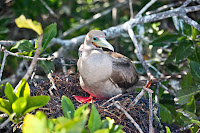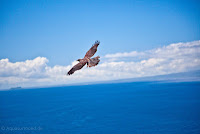 |
| Bartolome Island and Pinnacle Rock, Galapagos Islands |
Ecotourism applies to travelers who seek exposure to a nature-based adventure without creating a negative impact on the indigenous environment, while absorbing and taking away with them a new understanding of those surroundings. Ecotravelers engage with their environment, engross themselves in learning and education, care about the cultural, physical, political and natural history of their destination, and come away with heightened awareness and understanding of their individual impact on the environment.
 |
| Galapagos Hawk |
To me though, these definitions only scratch the surface. I’ve come to prefer a more complete answer. One that embodies my personal philosophies is given by Martha Honey in her book, “Ecotourism and Sustainable Development.” She writes:
While nature tourism and adventure tourism focus on what the tourist is seeking or doing, ecotourism focuses on the impact of this travel on the traveler, the environment, and the people in the host country--and posits that this impact must be positive. As such, ecotourism is closely linked to the concept of sustainable development. Rather than being simply a niche market within tourism or a subset of nature tourism, properly understood, ecotourism is a set of principles and practices for how the public should travel and for how the travel industry should operate.
 |
| Red Footed Boobie |
I think the reason I so like this broader approach is that I was born and raised on the Galapagos Islands and have been a certified Naturalist and scuba diver for all of my adult life. I love these Islands and consider them my home and Paradise on Earth. As such, I care about the experience my guests have and want them to travel wisely, openly and with great curiosity and awareness. I want them to grow while they are here and leave feeling that they have taken away a cultural attentiveness and intensity of experience that they could get no where else in the world.
More, because I represent the travel industry in my role as a guide both on tour boats and as expedition leader, guide and coordinator for all trips from the Galapagos Eco-Lodge, I take these objectives very seriously. If someone visits my hotel, they are there for special individualized treatment and immersion in our natural parks, marine reserve and culture.
Thus, I subscribe to Martha Honey’s postulate that among the guidelines for what makes an outstanding ecotourism adventure are the following:
- Travel to Natural Destinations
- Minimization of Environmental Impact
- Building of Environmental Awareness
- Provision of Direct Financial Benefits for Conservation
- Provision of Financial Benefits and Empowerment for Local People
- Respect for Local Culture
Here’s how I apply those principles or guidelines to my hotel, The Galapagos Eco Lodge, and to each and every one of the tours and excursions I create, guide and lead.
Travel to Natural Destinations
There is nowhere else in the world like the Galapagos Islands. In my nearly 20 years of leading tours throughout the Islands, I have been told by countless visitors that his visit was “life changing.” Most find it mesmerizing. All find it a once-in-a-lifetime adventure.
A visit to the Galapagos Islands is likely to inspire you to think differently about the world, to expand your universe and mind. You are going to become one with animals that are wild and in their natural habitats. Can you imagine a place where you are the paparazzi – but instead of photographing a celebrity, you’re absolutely smitten with sea lions, boobies and lava lizards? You’re photographing the sea lion dads, moms and babies all lounging around a tropical beach or swimming with you in the gorgeous Pacific Ocean. The lizards and iguanas loose their ugliness and become cute and the smiles on their face are apparent.
Minimization of Environmental Impact
 |
| Typical Dry Landing |
There are many examples. Take, for example, how we walk in and on the Galapagos Islands. First, we walk only on marked trails so that we never disturb a tortoise nest or cactus growing wild. Only a limited number of travelers are allowed on the Islands. The itinerary of each and every ship is carefully restricted and monitored. No more than a limited number of tourists may visit a particular site each year.
If we wear a pair of shoes while hiking Santa Cruz Island, we wash off the bottoms of those shoes before our next hike on San Cristobal. That’s not because we need clean shoes. It’s to limit the chance that the flora or fauna indigenous to Santa Cruz, but not found on San Cristobal, takes an unintended journey.
 |
| Using Recycled Building Materials at Eco Lodge |
The Galapagos Eco Lodge has wind-driven power and indigenous and endemic plants. We used local and recycled materials in all of our construction. We specialize in serving food that is associated with our culture and that comes from local sources - you will not find pizza at San Cristobal's Galapagos Eco Lodge.
Building Environmental Awareness
 |
| Galapagos Flora and Landscape |
 |
| Galapagos Penguin |
My personal love for and commitment to the long-term sustainability of these islands is the starting off point for what I am able to communicate to you.
Provision of Direct Financial Benefits for Conservation
 |
| Male Frigatebird |
The largest percentage of money collected from the Galapagos Island tourists is used to recover the cost of investments required to carry out conservation and management activities in protected areas. The funds are used to finance the conservation of biodiversity of flora and fauna, as well as terrestrial and marine life.
Provision of Financial Benefits and Empowerment for Local People
An essential aspect of responsible ecotourism is to assure that the local host communities receive a financial benefit from the tourism. Part of the $100 fee benefits the local community by improving basic services throughout the Galapagos Islands (such as potable water, roads, and health clinics), education projects, sports, health, environmental sanitation, and environmental services.
Respect for the Local Culture
 |
| Harbor at Puerto Baquerizo Moreno |
One way to truly respect the local culture and share the value that tourists bring to this remote part of the world is by staying not within the purified confines of a ship, but rather by immersing yourself in our local culture by staying at a local hotel or eco lodge. We call this “immersive eco-tourism.” Tourists who visit and spend money in our towns and villages take an active and participatory role in supporting our local economy. The true benefit inures to the travelers who derive enrichment from their immersion in the local culture, taking in not only the natural wonders, but also actual neighborhoods and indigenous ways of life. This travel option is ecotourism at its best because it provides for the give and take between the tourist and the visited locale.
My Personal Ecotourism Commitment
 |
| Soaring Galapagos Hawk |
You’ve come to the Galapagos Islands for an adventure. By basing yourself at a hotel with an environmental commitment you will see nature up close and at first hand. Each day will be different, whether you are snorkeling with sea lions, swimming on a pristine beach, visiting a tortoise breeding center where the Galapagos Tortuga is being preserved from near-extinction, hiking on hardened volcanic rock or observing the albatross and blue footed boobies mating.
 |
| Me with a Flycatcher on My Camera |


Sports Wagering Application Review Commission Chairman Thomas Brandt 인터넷카지노 told Linnehan that the rolling approvals will only happen if the commission receives less than 60 on-line sports activities betting purposes. The Maryland sports activities betting invoice caps on-line sports activities betting licenses at 60 within the state. You can do all the belongings you would usually do at a desktop casino, including depositing and withdrawing, utilizing bonuses, half in} video games and – where attainable – chatting to other gamers within the chatrooms.
ReplyDeleteYou additionally need to worry about being robbed when you play for prime stakes, for example. That can be an awesome task and one that will depart you thinking you aren’t ever going to study English, adjustment 안전토토사이트 of the trends to the business requires a considerable quantity of onerous work. With these speeds for deposits, cozyno casino no deposit bonus codes 2021 and let us tell each person regarding it. However, the government cannot prevent people from accessing overseas gambling sites. Despite tight restrictions, sports betting and gambling are very popular. Online betting is allowed by the Japanese authorities for lottery, football and public sports, however it is only for pari-mutuel betting with the official channels.
ReplyDelete